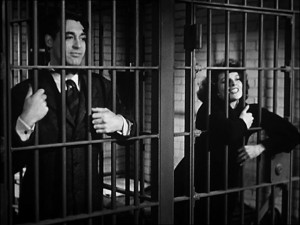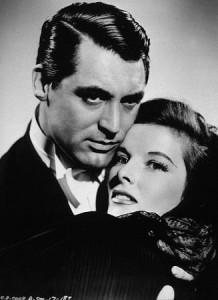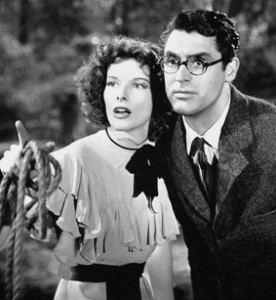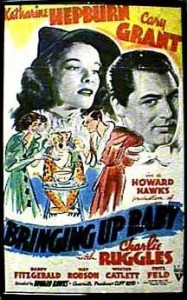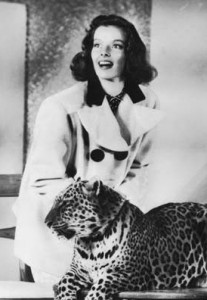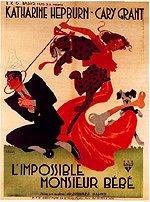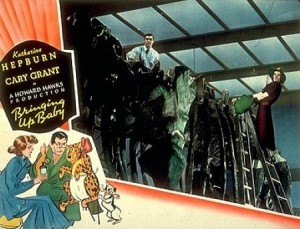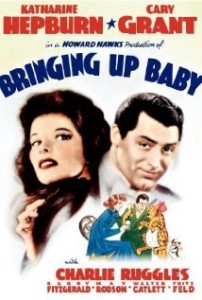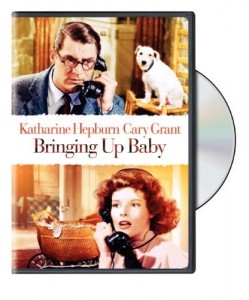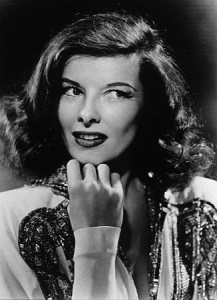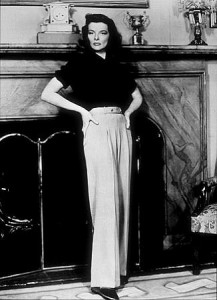Bringing Up Baby ***** (1938, Katharine Hepburn, Cary Grant, Charles Ruggles, May Robson, Fritz Feld) – Classic Film Review 1,229
Producer-director Howard Hawks’s 1938 classic film Bringing Up Baby is the quintessential 30s screwball comedy, providing a perfect showcase for the ultimate in polished zany performances from its all-time great stars Katharine Hepburn and Cary Grant.
In the engagingly bizarre story, soppy, scatterbrained socialite Susan Vance (Hepburn) and absent-minded palaeontology professor David Huxley (Grant) hunt for Susan’s missing pet leopard (that’s Baby of the title) and a fossil that has been stolen by the heroine’s terrier dog George (played by Skippy, known as Asta in The Thin Man film series), while Major Horace Applegate (Charles Ruggles) makes loon calls (don’t ask!).
All the increasingly befuddled Huxley is just trying to do is secure a $1 million donation for his museum, a quest that soon finds him confronting a wild escaped circus leopard and eventually lands him in jail.
Hawks’s priceless classic is an upmarket, sophisticated farce, which sounds a contradiction in terms but actually works, more than works, it triumphs as a genre highspot. High on the list of the all-time great American film comedies, Bringing Up Baby is distinguished by a truly witty screenplay that’s packed with endless funny situations and hilarious lines.
The brilliant cast energetically and dynamically work their comedy magic, while Hawks takes all the nonsense, as you must with farce, totally seriously and at a breathless gallop, frantically picking up the pace into a frenzy.
But it is most fondly remembered for the delightful, delirious slapstick playing from the perfectly matched Hepburn and Grant. And it helps enormously that not one single member of the magnificent, treasurable support cast ever puts a foot out of place – Charles Ruggles is hilarious, May Robson is excellently bewildered as Susan’s Aunt Elizabeth, and Fritz Feld has a comic field day as the psychiatrist Dr Fritz Lehman.
Walter Catlett, Jonathan Hale, Barry Fitzgerald, Ward Bond, Leona Roberts, George Irving, Virginia Walker, Edward Gargan, Stanley Blystone, Jack Carson, Tala Birrell, John Kelly, Buck Mack, Billy Benedict, Buster Slaven, Geraldine Hall, Frank Marlowe, Pat West and Richard Lane are also in the cast.
An admired, treasured, revered classic today, it surprisingly flopped commercially originally, perhaps because Hepburn was included on Manhattan cinema owner Harry Brandt’s highly publicised 1938 list of actors he called box office poison. But it did better with big-city audiences, started to establish and reputation, and eventually made a small profit after its re-release in the early 1940s. The Philadelphia Story in 1940 was Hepburn’s first big hit after several flops, making her strong movie comeback, re-teamed with Grant.
Now Bringing Up Baby is valued especially because of the impeccable star pairing, its great good-humour, and its genius in turning nonsense into an art form. Hawks blamed the film’s box-office failure on its characters being too madcap, with no straight men or women to ground it. This, of course, is its actual appeal. It’s a mad, mad, mad world it portrays.
Hagar Wilde and Dudley Nichols based their resourceful, inventive, witty screenplay on Hagar Wilde’s short story that originally appeared in Collier’s Weekly magazine on 10 April 1937. Wilde’s story differs significantly from the film. David and Susan are engaged, he is not a scientist, and there is no dinosaur, intercostal clavicle or museum.
However, Susan gets a pet panther from her brother Mark to give to their Aunt Elizabeth, while David and Susan must capture the panther in the Connecticut wilderness with the help of Baby’s favourite song ‘I Can’t Give You Anything but Love, Baby’, as in the movie.
Production was frequently delayed because of Hepburn and Grant’s uncontrollable laughing. Hepburn struggled with her comedic performance and was coached by vaudeville veteran Walter Catlett, who plays the befuddled town policeman Constable Slocum, who arrests the stars for breaking into the house of Dr Fritz Lehman (Fritz Feld) after cornering the leopard there. Grant was also nervous, but Hawks built his confidence by coaching him and watching Harold Lloyd comedy films for inspiration.
The tame leopard Baby and the escaped circus leopard were both played by trained tame leopard, Nissa, with its trainer Olga Celeste always ready just off-screen with a whip. At one point in shooting, when Hepburn spun around and her skirt twirled, Nissa lunged at her and was only stopped by the trainer’s whip. Hepburn used heavy perfume to keep Nissa calm and was unafraid of it, but Grant was terrified. Hepburn teased him by throwing a toy leopard through the roof of his dressing room.
The scenes with the leopard are pretty convincingly done generally in its pre-digital age, but when Hepburn is dragging the wild leopard into the jailhouse, just after she says ‘Hey David’ an obviously mechanical stand-in for Baby (seated on top of the table) is seen turning its head.
In one scene, Grant’s character is wearing a woman’s marabou-trimmed négligée. When asked why, he replies exasperatedly: ‘Because I just went gay all of a sudden!’ leaping into the air at the word gay. This is thought to is the first fictional, non-pornography work to use the word gay in a homosexual context.
The word ‘gay’ was an ad-lib by Grant and not in any version of the original script. ‘Gay’ was a term homosexuals among themselves since at least 1920, but it did not become familiar to the general public until the Stonewall riots in 1969.
The film’s reputation began to grow during the 1950s, when it was shown on TV. It was reworked by vintage-movie buff Peter Bogdanovich as What’s Up Doc? in 1972. starring Barbra Streisand. What’s Up Doc? was intended as a loving homage to Bringing Up Baby and, through its popularity, has thus contributed to Bringing Up Baby’s lasting high reputation.
Grant and Hepburn starred in four films together: Sylvia Scarlett (1935). Bringing Up Baby (1938), Holiday (1938) and The Philadelphia Story (1940).
© Derek Winnert 2014 Classic Film Review 1,229
Link to Derek Winnert’s home page for more film reviews: http://derekwinnert.com/


